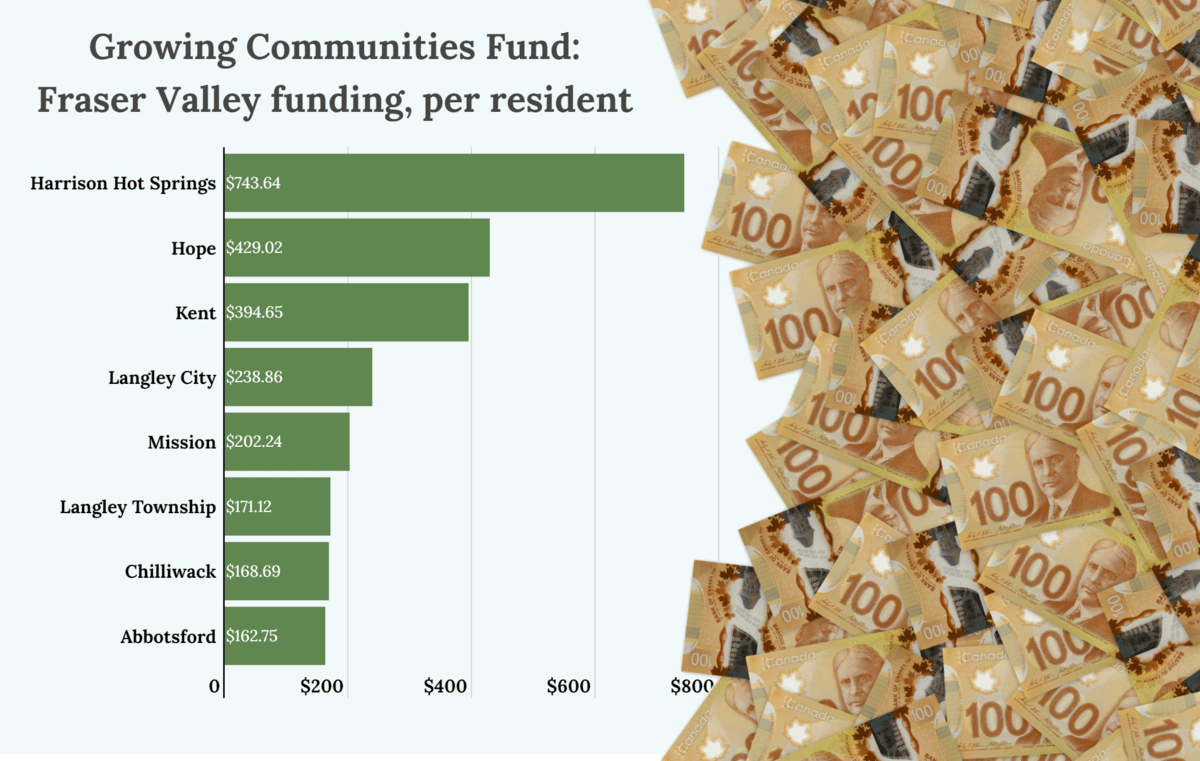- Fraser Valley Current
- Posts
- DATA: A big payday for small communities
DATA: A big payday for small communities
How BC's $1 billion payout to cities favours smaller towns

The Fraser Valley’s cities and towns were handed a cool $97 million last week.
But the surprise gift from the provincial government didn’t land equally.
The money came from a new, one-time “Growing Communities Fund” that the province created to dish out $1 billion from its surprise surplus this year.
But while municipalities bent over backwards to thank the province for the sudden influx of cash, on a per-person basis, some places made out much better than others.
How much did your community get?
If you or your town gets a piece of $1 billion, you probably want first to know how much it got. The money may go towards recreation facilities, roads, or maybe even to reduce the tax raise you’re likely to see this year or next.
Abbotsford: $27.4 million ($163 per person)
Langley Township: $24.3 million ($171 per person)
Chilliwack: $16.4 million ($169 per person)
Mission: $8.4 million ($202 per person)
Langley City: $7.2 million ($239 per person)
Hope $2.9 million ($429 per person)
Kent: $2.7 million ($395 per person)
Harrison Hot Springs: $1.3 million ($744 per person)
So why did Langley Township get a higher per-capita share than Abbotsford? Why did Hope get more than Kent? And what about Harrison’s windfall?
The answers boil down to the size of communities, growth rates, and a half-million dollar prize bonus for each of BC’s municipal halls, no matter the size.
Continues below
The formula
When it announced the cash infusion, the province declared that local governments will get “a $1-billion boost through one-time funding to address the needs of their growing communities.” The money comes with no obvious strings attached.
Two-thirds of the total money, the province said, was allocated based on the population of municipalities. The other third was based on their growth over the last five years. (The Current’s math suggests around 52% of the funds were based on population, 38.5% was based on growth, and 9.5% came from a base grant. The Current sought clarification from the provincial ministry of municipal affairs, but they refused to provide any more information on their population figures.)
Even if the numbers are accurate, they aren’t that simple, an analysis by The Current shows.
For one, those shares were for the total amount of money. Not all municipalities grew, after all, but all made out with at least half a million dollars. Meanwhile, the province’s largest cities, including Abbotsford and Langley Township, got the bulk of their money based on how much they grew, not how many residents they already had.
The population chunk was also not allocated evenly for all communities. The smaller the community, the more money a municipality got for each person. That was handled by providing less money for each additional person a community had above certain population thresholds.
A town would receive about $365 for each of its first 2,000 residents (so a town with 1,000 residents would get $365,000). But only those first 2,000 people were fully counted in the province’s “adjusted population” scheme. Each resident over the 2,000 mark counted a little less. At the extreme, every resident over the 150,000 threshold counted only five per cent towards its adjusted population. So for resident number 1, a city would receive $365. But for resident number 150,001 (and each subsequent citizen), a city got only around $18.
As for growth, those calculations were simpler: basically each community received around $1,000 for every additional resident it gained between 2016 and 2021. For a city like Abbotsford that added 17,000 people during that time period, the money from growth amounted to nearly $17 million—well over half the total it received.
Finally, each municipality also received a base $500,000 grant. For the smallest communities, that windfall amounted to the bulk of their funding. Take, for example the tiny Vancouver Island village of Zeballos—BC’s smallest municipality with just 122 residents (its population grew by nine people over five years). For Zeballos, the $500,000 amounted to more than $4,000 per person, and constituted the majority of its grant.
The combined result of the provincial formula gave smaller communities a much larger share of the total windfall than their population would have otherwise allowed. The province’s 23 smallest communities, for example, were given $15.7 million, but added only 105 new residents over the past five years. For a fund that touted the importance of addressing growth, that total amounted to about $682,000 per each additional resident in those communities.
(The bulk of the $15.7 million came via the base funding amount.)
There are reasons why smaller communities need greater shares of funding, though, Clearwater Mayor Merlin Blackwell wrote this week.
Blackwell, whose community has about 2,600 residents and received $1.5 million, noted that smaller towns have some of the same core staff and infrastructure needs as larger communities. But such baseline costs can overwhelm such communities, he said.
Blackwell praised the fund for providing money to cover some of those costs, and for being provided without the need for time-consuming applications.
Regional districts were also handed millions. The Fraser Valley Regional District was given $8.8 million of funding through a different formula, amounting to around $25.50 per person. (Metro Vancouver, of which the Langleys are a part, received $50.8 million, or about $15.50 for each resident.)
Reply